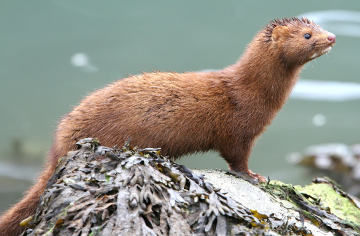Village News

PHOTO COURTESY OF GARRY KESSLER
An American mink.
November 8, 2019, Page A4
NATURE NOTES
By Annie Reid
Westborough Community Land Trust
Wild minks in the woods
What do most of us know of minks, those famous fur-bearers long sought for mink coats and stoles?
Most of us know little, and probably least of all that wild minks live – largely unseen – in our local woods. Why so unseen? That’s because they’re primarily nocturnal, doing most of their roaming and hunting at night.
What else don’t we know? Most of us probably wouldn’t guess that minks are semi-aquatic. They spend much of their lives around water – our lakes and streams – and in it. You’re most likely to spot a mink on a stream bank or a wooded or rocky lake shore. Minks are good swimmers, equipped with partially webbed toes and luxurious fur that repels water, thanks to thick underfur covered by long, oily outer guard hairs. They’re also adept at climbing trees.
It might be a surprise that minks are small – smaller than most housecats. By one estimate, it would take 55 wild minks to make a mink coat. Males can weigh about 3 pounds and are about two feet long, counting a furry tail that’s almost half their length. Females are smaller.
What do minks look like? As members of the weasel family (Mustelidae), American minks (Neovison vison, formerly Mustela vison) are long and skinny, with short legs and a pointed face. They’re a rich brown color, with a distinctive white patch under the chin.
These small sleek creatures are fierce predators, quick and active. They hunt in water, on shores, and in nearby woods. They catch fish, frogs, ducklings, muskrats, mice, voles, and more. Their streamlined shape enables them to dive under water for fish and to chase small mammals down holes, through tunnels, and into burrows. They don’t hibernate, so in winter they hunt under the ice and in tunnels under snow. What they don’t eat of a catch they store in their own burrow, which might be in a stream bank, under tree roots, or among rocks. If you find a 4-inch hole in such a place, it might be an entrance to a mink’s burrow.
Minks aren’t exactly sociable. Males and females have separate but overlapping territories. They mate in late winter but do not pair up. Like other female members of the weasel family, female minks can delay implantation of fertilized eggs, for up to 45 days. This unusual ability enables them to wait for favorable seasonal conditions. Four young, on average, are born in April or May and stay with the female through the summer.
Do any animals prey on our wild minks? Coyotes, bobcats, and great horned owls do.
It’s probably no surprise that humans have been the greatest danger to our native minks, hunting and trapping them for the fur trade. In the 20th century, raising minks in cages on mink ranches replaced most of the trapping of previous centuries. Today mink ranching has declined considerably since its height in the 1960s, as wearing fur became less fashionable. Other dangers posed by humans include habitat destruction (wet areas) and chemical pollution of waters.
This fall and winter, think of minks as you venture into the leafless woods or near frozen streams and ponds. If you travel to the Cape Cod Canal and walk the paths there, watch for minks among the rocks lining the canal.
Date index
Month (November)
Common name index
Scientific name index
Category index